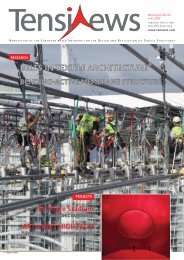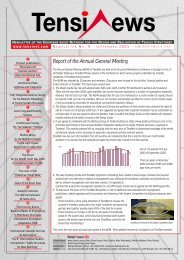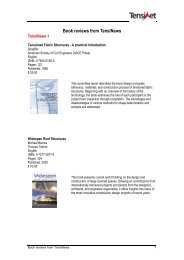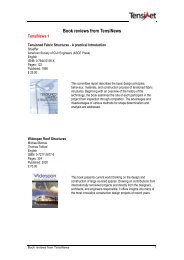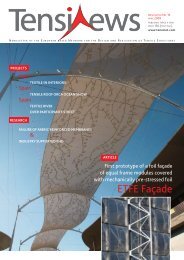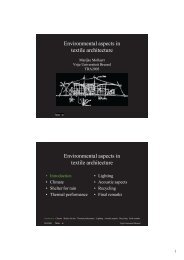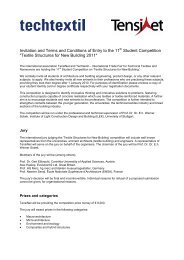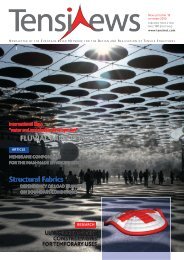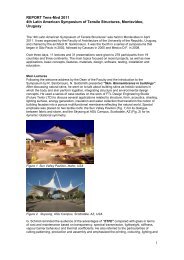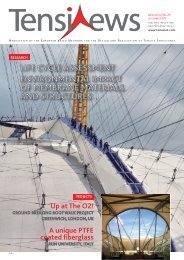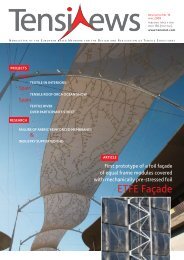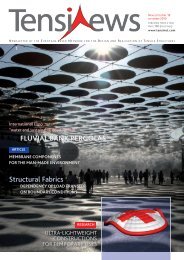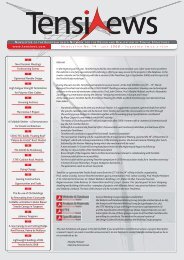TensiNews 13 - TensiNet
TensiNews 13 - TensiNet
TensiNews 13 - TensiNet
You also want an ePaper? Increase the reach of your titles
YUMPU automatically turns print PDFs into web optimized ePapers that Google loves.
TENSINEWS NR. <strong>13</strong> – DECEMBER 2007<br />
18<br />
C E M C O<br />
TENSINET<br />
SEMINAR<br />
LIGHTWEIGHT<br />
R O O F S<br />
TEXTILE<br />
SOLUTIONS<br />
On the 21st of June 2007,<br />
a seminar titled “Lightweight roofs.<br />
Textile solutions” was held in<br />
Madrid as part of the CEMCO<br />
2007 course organized by the<br />
Eduardo Torroja Institute for<br />
Construction Science. The event<br />
was attended by professionals<br />
from the textile industry,<br />
government officials and individual<br />
architects and engineers.<br />
The seminar addressed three main<br />
areas, with presentations by the<br />
following authors:<br />
1. Structural solutions<br />
- Ramón Sastre (UPC)<br />
- José Ignacio Lloréns (UPC)<br />
- Juan Murcia (IETcc)<br />
2. Functionality and materials<br />
- Paulo Mendoça (UMinho)<br />
- Joan Nos (FERRARI)<br />
- Feike Reitsma (IASO)<br />
- Jorge Neves (UMinho)<br />
3. Projects<br />
- Patrick Vaillant (IASO)<br />
- Javier Tejera (BAT)<br />
- Joan Nos (FERRARI)<br />
The seminar concluded with a<br />
round table moderated by Juan<br />
Monjo (IETcc), with the following<br />
speakers:<br />
- José Ignacio Lloréns (UPC)<br />
- Juan Murcia (IETcc)<br />
- Paulo Mendoça (UM)<br />
- Jorge Neves (UM)<br />
- Javier Tejera (BAT)<br />
The Iberian Section of TENSINET<br />
was publicly presented on the<br />
occasion of the seminar, and the<br />
translation into Spanish of the<br />
association’s Design Guide for<br />
Tensile Surface Structures was<br />
announced.<br />
Juan Monjo Carrió<br />
director.ietcc@csic.es<br />
Interview with the founder<br />
of the Membrane Structures<br />
master course in Dessau,<br />
Prof. Robert Off<br />
and students of the first semester,<br />
Dessau, April 2007<br />
The first international master course on textile architecture worldwide<br />
(www.membranestructures.de) started in March 2006 at the Anhalt<br />
University of Applied Sciences, instigated by Prof. Robert Off. The course<br />
which is addressed to engineers and architects aims to offer participation<br />
simultaneously with involvement in professional life by having one active<br />
week per semester while all other support and practice is communicated via<br />
the internet. The teaching staff consists of international academics and<br />
professionals in the field of textile architecture.<br />
After the first 3 semesters have passed the students of the first study course<br />
are starting their master thesis – time to consider progress. For this occasion<br />
Dr. Heidrun Bögner-Balz has met Prof. Robert Off and some students of the<br />
first course (Paolo Barroso (Brazil), Shehzad Irani (India), Alex Schön (South<br />
Africa), Sergio Leiva (Chile) and Xenia Diente (USA)) to talk about their<br />
impressions.<br />
BÖGNER-BALZ: How was the initial idea<br />
of the membrane master course<br />
born?<br />
OFF: The initial idea was not a single<br />
idea. There were two things<br />
probably coming together: First we<br />
were starting teaching about<br />
membrane structures at the<br />
Augsburg University of Applied<br />
Sciences and just out of a<br />
coincidence I was, for the third<br />
time, at Textile Roofs in Berlin.<br />
Everybody there, especially Marijke<br />
[Mollaert], was complaining that:<br />
we actually need a university based<br />
course to study - the workshop is<br />
just too short; and you only stay at<br />
the surface… So we just needed to<br />
have such a course and then I<br />
simply said: okay, let’s try. That’s it.<br />
The whole course and how it<br />
happened to be was not planned<br />
merely like this. The main reason<br />
why it became this kind of<br />
international course with one big<br />
permanent resident time in Dessau<br />
and then tutored through the<br />
internet was that there is no<br />
university which has the people<br />
who can teach all these subjects.<br />
So we had to collect them<br />
individually from other universities.<br />
And the only way you can do that<br />
is when they are not teaching at<br />
their home university. So we have<br />
chosen the semester-(holiday)<br />
breaks. But then they have only a<br />
short period. And how can you<br />
maintain the course? Actually the<br />
students come from all over the<br />
world; the teachers come from all<br />
over Europe for the moment. And<br />
then they spread again, go home<br />
and then the only way to<br />
communicate is the internet. And<br />
that was the idea. It was born<br />
within the discussion with Prof.<br />
Alex Furche. […] But what happens<br />
now is boosting the whole thing.<br />
The second course is incredible. We<br />
have a lot of requests for<br />
workshops from other universities<br />
from almost all over the world<br />
from these participants. What will<br />
happen is that ideas will spread and<br />
we will have a teaching network all<br />
over the world.<br />
BÖGNER-BALZ: And then you came to<br />
Dessau and found there the right<br />
place to start the course?<br />
OFF: Yes and no. I became Professor<br />
for project development at this<br />
university. I was not at the<br />
architectural faculty first. But I said:<br />
fine, let’s simply try it – it’s worth a<br />
try. And then I had to push and<br />
twist a few people - from the<br />
president who was enlightened by<br />
the idea to some people from the<br />
ministry. There is also another<br />
aspect to it. This school is in the<br />
new country of Germany, in<br />
Sachsen-Anhalt which was part of<br />
the former east. They now put a lot<br />
of energy in their universities… just<br />
thinking of the facilities, we’ve got<br />
everything here. They know they<br />
have to move into the future and<br />
don’t protect the past. That’s<br />
probably why it was possible from<br />
the beginning, with the president<br />
and the ministry, to find open ears.<br />
If I would have tried this at more<br />
established universities, they<br />
probably wouldn’t let me do it;<br />
they don’t have the need to move.<br />
[…] That’s one of the reasons plus<br />
the historical coincidence of the<br />
place – the Bauhaus. […] I think it’s<br />
a fantastic coincidence: the name<br />
of the Bauhaus, the place, and this<br />
isolated situation for the moment.<br />
This is all coming together - a lot of<br />
coincidence happening.<br />
We didn’t know that when we<br />
started, and what we can learn<br />
from this is probably – you just<br />
start and if you keep on trying<br />
things will come up, something<br />
different may come out at the end<br />
but you’ll get somewhere. […]<br />
BÖGNER-BALZ: What are the contents<br />
of the course?<br />
OFF: The course is intended to get a<br />
person being able to design,<br />
calculate, compensate and erect<br />
membrane structures - a sort of<br />
“Leonardo DaVinci” of membrane<br />
structures. He should be able to<br />
get into any field connected with<br />
membrane structures, to<br />
understand the limits of what we<br />
know, as well as all the possibilities<br />
of what we can do. That’s actually<br />
the idea.<br />
BÖGNER-BALZ: You started about a year<br />
ago. How many students have you<br />
got and how successful has the<br />
course been so far?<br />
OFF: The actual first course started<br />
eighteen months ago. The<br />
preparation for it also took two<br />
years. The first course started with<br />
21 participants and 20 are still<br />
there. We have already changed<br />
the second course a bit. We had to<br />
come down from 90 to 60 credits<br />
for the whole course. We learned a<br />
lot altogether from the first course.<br />
Still most of them are with us and<br />
already for the second course now<br />
we are fully booked. Actually we<br />
only offer 25 seats, that’s the<br />
absolute maximum. We don’t have<br />
more capacity.<br />
BÖGNER-BALZ: And you have already<br />
got some students registered for the<br />
following courses as far as I know?<br />
OFF: Yes, that makes me happy. We<br />
have eight students already who<br />
sent some files.




